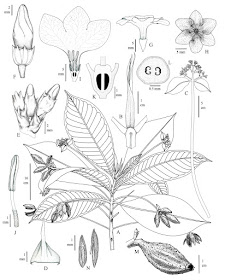 |
| Lintersemina chucuriensis H. Mendoza-Cifuentes, A. Celis & M.A. González
in Mendoza-Cifuentes, ... et González, 2020.
|
Abstract
A new genus, Lintersemina (Condamineeae, Rubiaceae), with a single species, L. chucuriensis is here described, based on recent collections made during a biological exploration to the Magdalena Medio Region of Santander Department, central portion of Colombia. This region is of high interest for both the high endemicity of its flora and fauna and the critical conservation status of this biodiversity due to high levels of deforestation. Lintersemina is unique within the tribe Condamineeae for the following combination of characters: axillary, long-pedunculate inflorescences, loculicidal capsules with 1-2 seeds per locule, and large navicular seeds. Based on phylogenies obtained using plastid and nuclear sequence data, the genus is positioned in the Condamineeae (subfamily Ixoroideae), as a sister group to the genera Simira and Parachimarrhis. This new genus is only known from two localities at the foothills of the Yariguíes National Park, in the municipalities of El Carmen de Chucurí and Zapatoca, at 400–800 m elevation, in forest undercanopy, near streams. Threats of deforestation and a very low population density were assessed, and this species classified as Critically Endangered (CR) following IUCN criteria. Full description and illustrations are also included.
Keywords: Conservation, flora of Colombia, Santander, Tropical humid Forest, Eudicots
Taxonomy
Lintersemina H. Mendoza-Cifuentes & A. Celis & M.A. González, gen. nov.
Type species:— Lintersemina chucuriensis H. Mendoza-Cifuentes, A. Celis & M.A. González
Diagnosis:— This new genus is unique within the tribe Condamineeae by the following combination of characters: axillary, long-pedunculate inflorescences, ovary with 1–2 ovules per locule, loculicidal capsules, and large, terete, navicular (boat-shaped) seeds. Treelet. Leaves opposite, decussate, petiolate; petioles slightly thickened at the base; blade venation brochidodromous, with secondary veins ascending and arcuate. Stipules interpetiolar, readily caducous, only found at apical buds and youngest nodes, with colleters in adaxial surface, resinous. Inflorescences axillary, subterminal, corymbose cymes, pedunculate, many-flowered; with two types of bracts, the basal ones subtending the inflorescence leaf-like, the distal ones triangular. Flowers hermaphroditic, protandrous, 5- or 6-merous, actinomorphic, pedicellate, erect. Calyx persistent in fruit. Corolla aestivation left-contorted. Stamens included; anthers opening by longitudinal slits. Ovary 2-locular, placentation axile, ovules 1 or 2 in each locule; style included, with two stigmatic branches. Fruit a loculicidal capsule. Seeds >1 cm long, terete, navicular, with membranaceous structures along the raphe. A monospecific genus, endemic to Magdalena Medio Region of Colombia, growing in tropical rainforest.
Etymology:— The name of this genus refers to its navicular (boat-shaped) seeds.
Lintersemina chucuriensis H. Mendoza-Cifuentes, A. Celis & M.A. González, spec. nov.
Habitat:— Lintersemina chucuriensis grows in shady undercanopy of tropical forest, near streams (Figure 7).
Distribution:— Lintersemina chucuriensis is known from two localities in the Santander Department, Colombia,
between 400 and 800 m elevation, in the lower part of the western foothills of the Cordillera Oriental, area associated
with the ecoregion known as the Magdalena Medio (Figure 6). The forest at the site comprises the last remains
of lowland inter-Andean rainforests in the Colombian Magdalena River valley region, and its condition consists of
fragments in the matrix of paddocks and cocoa crops; most of the trees valuable for timber have been harvested (Figure
7).
Humberto Mendoza-Cifuentes, Angela Celis, Eduardo Tovar, Mailyn A. González. 2020. Lintersemina (Rubiaceae: Condamineeae), A New and Enigmatic Genus from the Magdalena Medio Region of Colombia. Phytotaxa. 451(1); 1–20. DOI: 10.11646/phytotaxa.451.1.1


